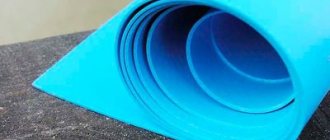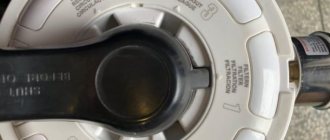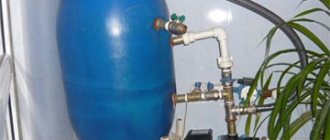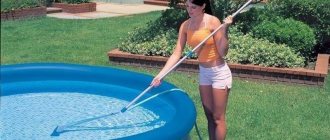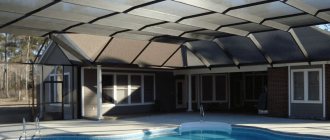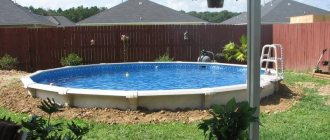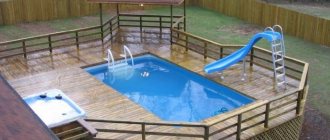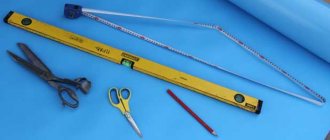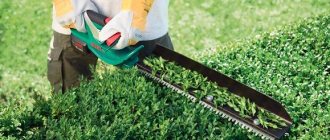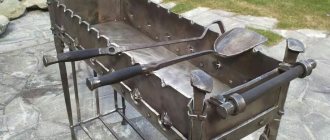Pool filters: types and design features
All filter models have a single purpose - purifying water and blocking microparticles to avoid contamination. The difference in characteristics is the presence of additional operating modes and design features.
Sand pumping stations
Sand filters are the most cost-effective cleaning systems. The design consists of a sealed plastic container, which has two holes used for supplying and discharging liquid.
The container is filled with quartz sand, which plays the role of a filter. Heavy metal salts and organic suspensions remain in the quartz layer. The same applies to chemical compounds formed as a result of pool disinfection.
The disadvantage of this equipment is its inability to filter particles smaller than 20 microns. Operating period – 3 years.
Attention! You can increase the quality of purification and the service life of the filter system up to 7 years if you choose glass sand instead of quartz sand.
It is even better to use a combined filler. It contains sand, gravel and crushed stone in layers.
The sand system is easy to use; cleaning is done by flushing during pumping back. Limescale deposits are removed with special compounds that are introduced into the system for a certain time when the pump is turned off. Afterwards you need to perform the standard cleaning process.
The inexpensive cost and ease of maintenance of this pool filter have made the equipment universal and popular, but there are also certain nuances: the large size and weight of the cleaning device.
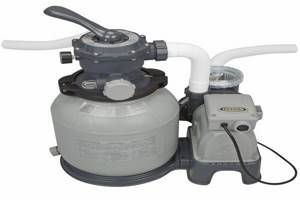
Diatoms (earth)
Diatomaceous earth equipment is the most expensive among all mechanical cleaning devices. Diatomite powder is used as a filter composition - a special rock that consists of decay products of algae and hollow shells of microorganisms.
Diatomite powder undergoes heat treatment before use: it is calcined in a special oven with a temperature of 1200C for at least a day. This helps to get rid of organic impurities and create a homogeneous fine filter fraction.
Filters are manufactured in several versions:
- The design of the filter resembles sand equipment. The difference is that diatomaceous earth powder is used instead of sand.
- The filter consists of cartridges installed in series in a housing, through which water passes. This makes it possible to perform maximum cleaning, removing contaminants up to 2 microns.
Attention! Due to the ability of diatomaceous earth to saturate water with silicon, its use helps reduce the use of chemically aggressive cleaning compounds by 85%.
It is no secret that silicon water has rejuvenating and healing properties. It is for this reason that such expensive pool filters based on diatomaceous powder successfully compete with budget sand filter devices.
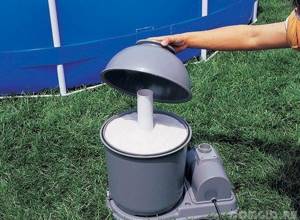
Cartridge disposable
Membranes made of propylene plates are used as the working element of the filter unit. They do not allow organic particles larger than 10 microns and heavy metal salts to pass through. The efficiency of cartridge filters for pools is almost twice as high as compared to sand filter devices.
The design consists of a box with a removable lid, where the cartridge is located inside. There is also a plastic bag here, which is intended for collected garbage.
Advantages of cartridge filter equipment:
- effective cleansing;
- small sizes;
- no backwash required;
- long working life.
Taking into account the contamination, the cartridge is taken out of the box and washed. Its operation time will depend on the volume of the pool, and is up to 1 year. For uninterrupted operation of filtering equipment, it is recommended to have spare cartridges.
Often modern models of cartridge systems are installed in a common housing of portable cleaning equipment, which is where another name for the device comes from – filter pumps.
Despite effective cleaning and ease of maintenance, cartridge filter systems are not as common as sand ones, this is due to their high cost.
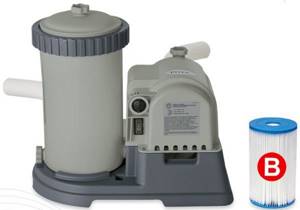
Which one is better to choose?
Often, when purchasing ready-made ponds, the kit includes a special filtration pump for cleaning the pool. Facts about such equipment :
- This type of filtration is the most appropriate choice for frame pools. It promotes the circulation of water throughout the reservoir and at the same time cleans it of various debris.
- Needs cleaning from time to time.
- If we talk about durability, the device works for two thousand hours , which is approximately two summer seasons. Considering its low cost, this is quite acceptable.
- The disadvantage of the filter is that it purifies the water only from the dirt that floats on the surface ; the debris that settles to the bottom remains there. It all depends on the power.
As a rule, very powerful filters are not included in the kit, but if you choose a filter yourself, pay attention to the power of its operation . After all, if it ensures fast enough circulation of water, the dirt will definitely not have time to settle.
How to choose a filter system: tips and tricks
The main criterion when choosing a filter is the throughput capacity of the equipment. This indicator is determined by liters or cubic meters of water that the installation purifies in one hour.
Modern models can filter out even microscopic particles. The effectiveness of water purification is determined by the type of filter used and the circulation rate.
At low speeds, the water is purified as much as possible. Moreover, one condition must be observed: the volume of liquid must pass through the filter at least 3 times.
When choosing a pump, you need to take into account the volume of the pool. Remember, increasing the rate of fluid circulation through the filler will reduce cleaning efficiency. It is logical that for powerful pumping equipment it is necessary to choose a filler with a larger capacity.
Today, filters and cleaning systems can be purchased as a set, that is, there is no need to select a container for the filter or vice versa. Finding out the performance of the equipment is not difficult. Why do you need to multiply the volume of liquid in the pool by 2.5 and divide by 10?
For example, the pool has dimensions of 12x5x3 and holds 180 tons of water. We calculate: 180x2.5/10=45 m3/hour. The pool filter must be selected taking into account the calculated performance.
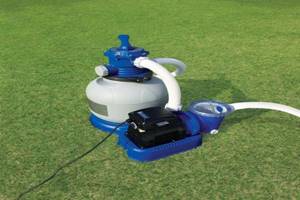
Washing and cleaning methods
Each device has its own washing characteristics. Learn more about how to clean your pool filter.
Cleaning the sand filter involves
flushing the hose from time to time .
Also, as written above, quartz sand should be changed every one and a half to two years. No special care required. Cleaning the cartridge filter involves rinsing the device under strong water pressure , it is better if the stream is sprayed. After rinsing, let the cartridges dry completely, then shake it thoroughly to remove any remaining debris, or you can run a small brush over it.
These are only the first stages of cleaning, now comes chlorination , dip the filter in a solution with a chlorine to water ratio of 1/6. Close the bucket with a lid and leave it for 2-3 days, ideally 5 days. After this period, rinse the cartridges with water and leave to dry. Cleaning done!
Washing a diatomaceous earth filter is simply washing out the diatomaceous earth inside and removing the waste material. This should be done by professionals, since such material can be dangerous . For normal operation of this device, it is necessary to change the diatomaceous earth plates from time to time.
The choice of filter is yours; whether you focus on price or some other criteria is your right. We recommend devoting at least a couple of hours to selecting this device in order to purchase something truly worthwhile and of high quality. And remember that you need to take into account not only the characteristics of the device, but also how suitable the filter is for your pond .
Rating of the best models
Nowadays you can buy any model of pool filters in stores. Taking into account the client’s wishes, managers will always select the required product in terms of performance and in the appropriate price category. The most popular cleaning systems include the following.
Aquaviva V700(B)
The filter is made of plastic and fiberglass with sand placed inside the container and a hose for connecting water from above. It has a high throughput capacity and can be installed for pools up to 80,000 liters.
Characteristics:
- weight of loaded sand – 215 kg;
- productivity – 20.2 m3/h;
- pressure – 2.5 bar;
- price – 21200-25600 rub.
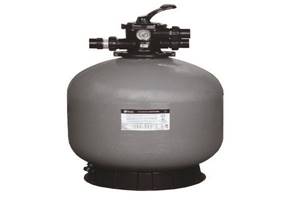
MTH (skimfilter) IS6
This cartridge pool filter is used for cleaning, supplying and removing liquid. This model is suitable for frame structures, since installation is carried out directly on board.
Characteristics:
- power - 0.15 kW;
- cleaning method – cartridge;
- productivity – 5 m3/h;
- price – 46200-47500 rub.
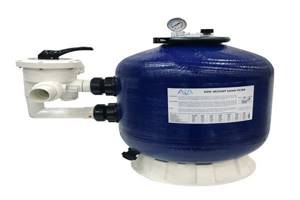
Emaux SP650
Installed for mechanical cleaning of buried or above-ground reservoirs. Sand is poured as a cleaning element. The filter can be selected for pools with a volume of 31-61 thousand liters.
Characteristics:
- productivity – 15.3 m3/h;
- weight – 14 kg;
- pressure – 2 bar;
- cost – 13200-14300 rub.
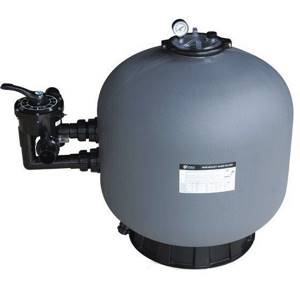
Hayward Star Clear C500
In this model, the cartridge is made of a special fiber that provides cleaning from contaminants up to 22 microns. The cartridge is installed in a cylinder 745x267 mm; on top there is a cover with a screw-type lever and a pressure gauge.
Characteristics:
- cleaning method – cartridge;
- productivity – 11.3 m3/h;
- power – 3.5 kW;
- cost – 28500-31000 rub.

TM Intex (28602)
A cartridge filter is used to circulate water and clean it from contaminants. An “H” type cartridge lasts up to 1 month.
Characteristic:
- productivity – 12.5 m3/h;
- power supply – 220 Volts;
- price – 2300 rub.
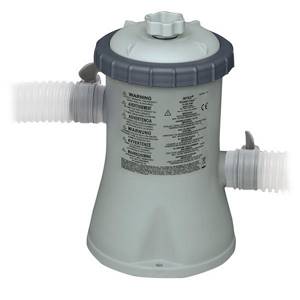
INTEX 26652
Sand filter for mechanical cleaning. Quartz sand is used as a filtering agent. Can clean volumes up to 65,000 liters.
Characteristics:
- power – 9.5 hp m3/h
- throughput – 12000 l/h;
- all sand – 50 kg;
- cost – 13600 rub.

First connection and nuances of operating the installation
Operating a pool filter is easy. Sand devices are most often used; they need to be washed approximately every 10-14 days.
Modern models have an indicator with which you can see that the filter needs cleaning. To do this, you need to use the “BACKWASH” knob; turning it backwashes all equipment. Filter sand needs to be replaced approximately every 2 years.
Attention! The filter must be turned on several times a day, so the water will circulate throughout the pool, that is, the pump must be turned on for 6-10 hours every day.
When sand cleaning, the water in the pool is also renewed during the process of washing the device. For the filter to work in this mode, it is necessary to change about 5% of the water every 7-10 days.

Water filtration systems for swimming pools
The benefits and pleasure of swimming in a pool depend primarily on the quality of the water.
Therefore, it is necessary to provide for all the subtleties associated with its maintenance at the initial stage of design and construction. Only competent care of a plastic pool can guarantee one hundred percent cleanliness, safety and comfort of a personal pond. Any polypropylene pool must be equipped with water purification equipment
ensuring its sanitary safety. The following must be carried out without fail:
- pool room ventilation and heating
- circulation (drain) and water supply
- water filtration and disinfection
Swimming pools located outside indoor areas are especially susceptible to various types of contamination. Dust, leaves, insects, rainwater and dirt regularly get into the bowl. But special means for covering the pool (such as plastic pavilions, covers, floating blinds, water awning) will help reduce pollution problems to a minimum.
ORDER ACCORDING TO MY REQUIREMENTS
However, complete water purification can only be achieved with the help of filtration systems, because in addition to small debris, the water also contains other organic impurities: hair, sweat, skin particles. In addition, filtering water in a plastic pool will significantly reduce the cost of chemicals for water disinfection.
In addition to the filter unit, you can use disinfecting devices: a station for dosing chemicals, an ozonizer, an ultraviolet lamp.
How to make a pool filter with your own hands
To make a sand filter, you need to find a plastic or iron container with a volume of approximately 80 liters. The main condition is that the entrance from above must be wide.
The tank must be placed near the pool and filled with sand, ideally quartz. Additionally, 3 intermediate layers of graphite can be arranged.
Then you need to connect the pump, connect one end of the hose to the tank, and the other to the drain. This filter unit requires daily cleaning. Why turn off the filter and set it to washing mode for 10 minutes. The sand must be compacted, then switch the pump back to filtration.
The efficiency of this system is slightly lower than that of industrial equipment, but it will save on cleaning costs. Before frost, the equipment is removed.
The filter is important for keeping the pool clean and preventing water contamination; you should not skimp on this equipment. And to choose the device that is required for a particular pool, you can consult with specialists; they will be able to help you make the right choice.
Errors during use - what, consequences, how to avoid?
| Error | What does it lead to? | How to avoid |
| Introduction of chlorinating substances into the filter system | Problems with the filter and pump. | Add reagents to the pool water. |
| Mixing concentrated cleaning chemicals together. | Filter and pump parts will be destroyed. | Administer substances separately. |
| Water purification only with a sand filter, without the use of special means. | Fine suspension, bacteria and microorganisms will remain in the water - they are too small for the sand from the filter to retain them. | Use coagulants, algae control agents, and collect fallen sediment with a special vacuum cleaner. |
| Poor sand washing during first filling | Dirt from the sand will settle in the central part of the tank and the next time the pump is turned on, it will fall into the pool water. | Pre-rinse the sand. |
| Using sand that is too coarse | Poor water purification. | Use sand of sizes recommended by the manufacturer. |
| No pH level check - it should range from 7 to 7.6. | At a low level, the water will become an aggressive environment - it will turn green, the chlorine added to it will be quickly consumed, and rust will appear on the metal parts. And if the indicator is high, turbidity will appear in the water, which the coagulants will not be able to cope with, and calcium will begin to settle on the walls of the pool and inside the equipment. | Check the level with a special tester. Apply the pH level adjuster through the pool skimmer in filtration mode. |
All the most important and useful information about sand filters for pools is in this section.
